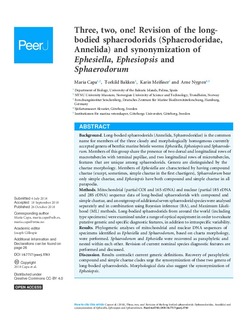| dc.contributor.author | Capa, Maria | |
| dc.contributor.author | Bakken, Torkild | |
| dc.contributor.author | Meissner, Karin | |
| dc.contributor.author | Nygren, Arne | |
| dc.date.accessioned | 2019-02-05T10:31:32Z | |
| dc.date.available | 2019-02-05T10:31:32Z | |
| dc.date.created | 2018-11-25T21:33:45Z | |
| dc.date.issued | 2018 | |
| dc.identifier.citation | PeerJ. 2018, 6 . | nb_NO |
| dc.identifier.issn | 2167-8359 | |
| dc.identifier.uri | http://hdl.handle.net/11250/2583902 | |
| dc.description.abstract | Background
Long-bodied sphaerodorids (Annelida, Sphaerodoridae) is the common name for members of the three closely and morphologically homogenous currently accepted genera of benthic marine bristle worms: Ephesiella, Ephesiopsis and Sphaerodorum. Members of this group share the presence of two dorsal and longitudinal rows of macrotubercles with terminal papillae, and two longitudinal rows of microtubercles, features that are unique among sphaerodorids. Genera are distinguished by the chaetae morphology. Members of Ephesiella are characterised by having compound chaetae (except, sometimes, simple chaetae in the first chaetigers), Sphaerodorum bear only simple chaetae, and Ephesiopsis have both compound and simple chaetae in all parapodia.
Methods
Mitochondrial (partial COI and 16S rDNA) and nuclear (partial 18S rDNA and 28S rDNA) sequence data of long-bodied sphaerodorids with compound and simple chaetae, and an outgroup of additional seven sphaerodorid species were analysed separately and in combination using Bayesian inference (BA), and Maximum Likelihood (ML) methods. Long-bodied sphaerodorids from around the world (including type specimens) were examined under a range of optical equipment in order to evaluate putative generic and specific diagnostic features, in addition to intraspecific variability.
Results
Phylogenetic analyses of mitochondrial and nuclear DNA sequences of specimens identified as Ephesiella and Sphaerodorum, based on chaeta morphology, were performed. Sphaerodorum and Ephesiella were recovered as paraphyletic and nested within each other. Revision of current nominal species diagnostic features are performed and discussed.
Discussion
Results contradict current generic definitions. Recovery of paraphyletic compound and simple chaetae clades urge the synonymization of these two genera of long-bodied sphaerodorids. Morphological data also suggest the synonymization of Ephesiopsis. | nb_NO |
| dc.language.iso | eng | nb_NO |
| dc.publisher | PeerJ | nb_NO |
| dc.relation.uri | https://peerj.com/articles/5783/ | |
| dc.rights | Navngivelse 4.0 Internasjonal | * |
| dc.rights.uri | http://creativecommons.org/licenses/by/4.0/deed.no | * |
| dc.title | Three, two, one! Revision of the long-bodied sphaerodorids (Sphaerodoridae, Annelida) and synonymization of Ephesiella, Ephesiopsis and Sphaerodorum | nb_NO |
| dc.title.alternative | Three, two, one! Revision of the long-bodied sphaerodorids (Sphaerodoridae, Annelida) and synonymization of Ephesiella, Ephesiopsis and Sphaerodorum | nb_NO |
| dc.type | Journal article | nb_NO |
| dc.type | Peer reviewed | nb_NO |
| dc.description.version | publishedVersion | nb_NO |
| dc.source.pagenumber | 31 | nb_NO |
| dc.source.volume | 6 | nb_NO |
| dc.source.journal | PeerJ | nb_NO |
| dc.identifier.doi | https://doi.org/10.7717/peerj.5783 | |
| dc.identifier.cristin | 1634748 | |
| cristin.unitcode | 194,31,10,0 | |
| cristin.unitname | Institutt for naturhistorie | |
| cristin.ispublished | true | |
| cristin.fulltext | original | |
| cristin.qualitycode | 1 | |

